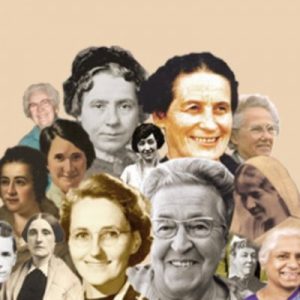Brigida, abbess of Kildare
Brigida (5), V., abbess of Kildare—Feb. 1, 523. The designation “Fiery Dart” seems peculiarly appropriate for “the Mary of Ireland,” who, although her fame on the continent is eclipsed by the greater reputation there of her namesake the widow-saint of Sweden, yet stands forth in history with a very marked individuality, though the histories that have come down to us are mainly devoted to a narrative of the signs and wonders which God wrought by her. As to her Acts, Colgan has published six Lives in hisTrias Thaumaturga, and the Bollandists five. It is more difficult to trace the historical points in St. Bridget’s life than to recount the legendary accretions which testify to a basis of fact, could we but find it after so many centuries. In the legend there is no little beauty, and in almost all we find an undercurrent of true human feeling and deep Christian discernment. (See some of them given at length in Bp. Forbes’s Kal. Scott. Saints, 288 seq., from Boëce, Breviary of Aberdeen, and Colgan’s Tr. Thaum. For a full and critical account of her life, see Lanigan, Eccl. Hist. Ir. i. 68, 335, and chaps. viii. and ix. passim; Todd, Book of Hymns, i. 65 seq.; O’Hanlon, Ir. Saints, ii. 1 seq.; Baring-Gould, Lives of the Saints, ii. 14 seq.) Her chief residence was the monastery of Kildare, “cella quercus,” which she founded; but affiliated houses of both men and women (“de utroque sexu”) were raised all over the country, she being abbess above all other abbesses, and the bishop with her at Kildare being similarly above all bishops in her other monasteries. Montalembert (Monks of the West, Edin. ii. 393-395) gives an account of St. Brigida and her monasteries, and places her birth at a.d.467 and her death at a.d.525. He says, “There are still 18 parishes in Ireland which bear the name of Kilbride or the Church of Bridget” (ib. ii. p. 395, n.). The Irish annals, however, vary as to the date of her death, but the most probable, and resting on highest authority, is a.d.523 (O’Conor, Rer. Hib. Scrip. iv. 13; Bp. Forbes, Kal. Scott. Saints, 287). In Scotland the cultus of this saint was very extensive, her dedications being chiefly found in the parts nearest to Ireland and under Irish influence. (For a short list see Bp. Forbes, Kal. Scott. Saints, 290-291.)

Leave a Reply